Mid-season carrot variety Losinoostrovskaya
Carrots are one of the most popular vegetable crops. Losinoostrovskaya occupies a special place among the variety of varieties. Its advantages are the excellent taste of root vegetables, their universal application and long-term storage with minimal maintenance.
The content of the article
Description of the Losinoostrovskaya carrot variety
Losinoostrovskaya - table variety of carrotscharacterized by large orange roots with juicy and sweet flesh.
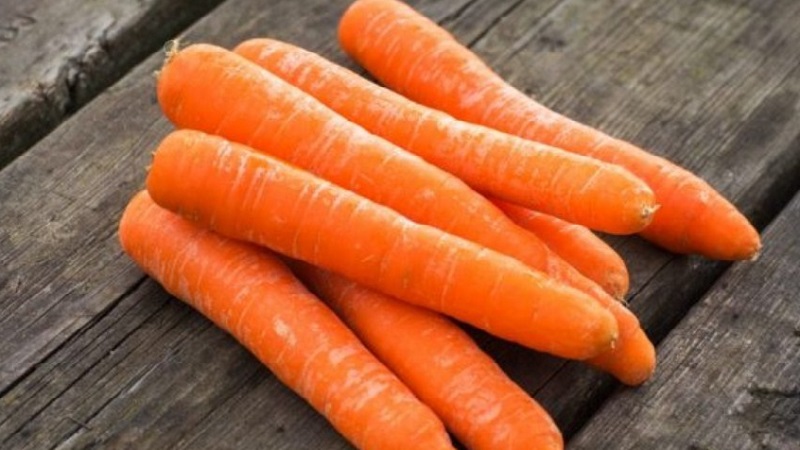
Origin
The variety was bred in the middle of the 20th century. at the Federal State Budgetary Scientific Institution "Federal Scientific Center for Vegetable Growing" by crossing carrots Amsterdam, Touchon, Nantes-4 and other varieties with a cylindrical shape of root crops.
Chemical composition, trace elements and vitamins, useful properties
100 g of carrots contain:
- sugar - 9%;
- beta carotene - about 28 mg;
- ascorbic acid - 5 mg;
- vitamin PP - 1 mg;
- B1 - 0.06 mg;
- B2 - 0.07 mg;
- B5 - 0.3 mg;
- B6 - 0.1 mg;
- calcium - 27 mg;
- magnesium - 38 mg;
- sodium - 21 mg;
- iron - 0.7 mg;
- zinc - 0.4 mg.
Regular eating a vegetable promotes normalization of metabolism, increasing immunity, ensuring the normal function of the organs of vision. Carrot juice is useful for anemia, people with hypo- and avitaminosis A, gallstone disease, metabolic polyarthritis.
Application features
Root vegetables are suitable for frost, conservation, cooking juices, mashed potatoes and desserts. They are eaten fresh, added to stews and mashed soups, and used as a snack (for example, Korean carrots).
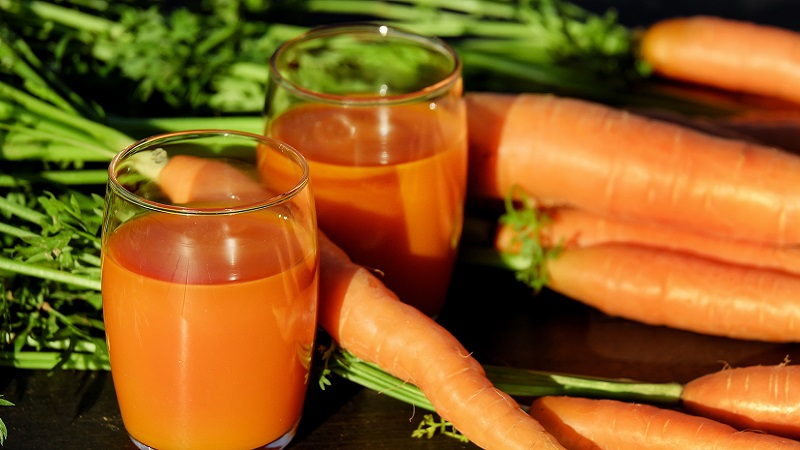
Ripening period and yield
This is a mid-season variety - harvest is ready for harvesting 80-118 days after germination.
Average yield is 5.4-7.7 kg / m².
Disease resistance
The variety is resistant to most diseases characteristic of the culture., but it can be affected by phomosis, white rot, bacteriosis and rhizoctonia.
Characteristics, description of appearance, taste
Losinoostrovskaya has straight or slightly spreading tops 35-40 cm high... The rosette consists of 13, less often 11 saturated green leaves of a diamond-shaped or triangular shape with a strongly indented contour.
Cylindrical root crops with a rounded or pointed end reach 12.5-16 cm in length, 3.2-4.2 cm in diameter and weigh 75-165 g. The surface is smooth, with small eyes and thin lateral root processes.
The peel is thin, with a slight glossy shine, the flesh is orange, the core is pronounced, round in section or resembles a polyhedron.
The pulp is juicy and sweet, without bitterness.
Growing regions and climate requirements
The variety is included in the State Register with a recommendation for growing in the North-West, Central, Volgo-Vyatka, Central Black Earth, North Caucasian, Middle Volga, West Siberian and Far Eastern regions.
Advantages and disadvantages of the variety
The main advantages of the variety:
- juicy and sweet pulp;
- good commercial qualities;
- delicate core structure;
- high carotene content;
- frost resistance;
- immunity to many typical diseases and pests;
- lack of tendency to cracking and color;
- abundant productivity;
- the possibility of universal application;
- long-term storage and good keeping quality.
No flaws were found at Losinoostrovskaya.
Difference from other varieties
In addition to the increased carotene content in comparison with most carrot varieties, the peculiarity of Losinoostrovskaya is the absence of a green circle at the base of the root crop - where it grows together with the tops. This is due to the fact that throughout the growing season the root crop is completely submerged in the ground.
Features of planting and growing
The variety is unpretentious in care, but to obtain a high-quality harvest, it is necessary to choose the right planting site and comply with the basic agrotechnical requirements of the crop.
Preparing for landing
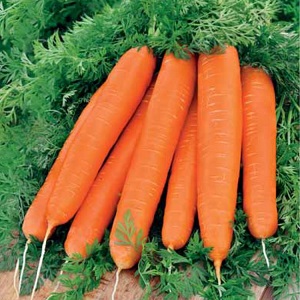 Before boarding remove residual essential oils from seeds... To do this, they are poured into a gauze bag, dipped into a container with warm (+ 44 ... + 48 ° C) water, rinsed 2-3 times and left until the water reaches room temperature. After that, the seeds are transferred to a sieve, washed with running water and laid out on a napkin to dry.
Before boarding remove residual essential oils from seeds... To do this, they are poured into a gauze bag, dipped into a container with warm (+ 44 ... + 48 ° C) water, rinsed 2-3 times and left until the water reaches room temperature. After that, the seeds are transferred to a sieve, washed with running water and laid out on a napkin to dry.
Then the planting material placed between two layers of linen cloth dipped in a growth stimulant solution ("Epin", "Kornevin"), leave for a day, then rinse with running water and leave for 6 hours in a dark cool place for hardening.
After 6 hours, the seeds are laid out on the same damp cloth, placed in a wide, shallow container, covered with foil and removed to a warm place. The fabric is periodically moistened, and the film is removed so that the seeds receive oxygen.
Plot from autumn cleaned of plant debris, dug up on a shovel bayonet and fertilize with compost or humus (1 bucket per 1 m²).
In the spring, the soil is dug up again, leveled, watered abundantly with warm (+ 50 ... + 60 ° C) water and covered with a garden film to create a greenhouse effect and avoid drying out.
Ground requirements
The variety grows and develops in light, nutritious soil with good moisture permeability, aeration and neutral acidity (pH 6.0-7.0). The best option is loamy, ash, sandy soils and a substrate consisting of peat, ash, sand and needles.
Reference. Sand is added to heavy soil at the rate of 12 kg per 1 m², to acidic - chalk, lime or cement dust.
Predecessors
Carrot grows well after potatoes, tomatoes, lettuce, green manure, onion and garlic.
Timing, scheme and landing rules
Seeds are sown before winter (in October) or in spring (late March - early April)... The main thing is that the soil is warmed up to at least + 5 ° C.
Landing order:
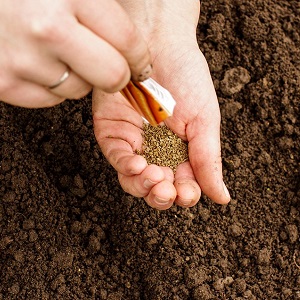 Prepare the beds in the selected area, located at a distance of 30-40 cm from each other.
Prepare the beds in the selected area, located at a distance of 30-40 cm from each other.- Every 30 cm, make grooves in them 1 cm deep (for loam) or 2 cm (for sandy loam).
- Place seeds in them, observing the distance between the seeds of 4.5-5 cm.
- Sprinkle the plantings with earth.
For the convenience of sowing seeds pre-glued on a thin paper tape.
Growing features
The growth and development of vegetables depends on the composition of the soil and climatic conditions.... If sowing was carried out at a temperature of + 8 ... + 9 ° C, seedlings will appear in 26-34 days, at + 25 ° C - after 7-10 days.
The active development of root crops begins at a temperature of + 15 ... + 19 ° C, the optimal indicators for the growth of greenery are + 20 ... + 24 ° C.
Reference. In hot weather, with soil temperatures above + 25 ° C, root crops slow down in development.
Losinoostrovskaya does not have special requirements for care, but there are some features.
Watering mode
Plants are watered every 3 days at the rate of 3 liters of water per 1 m²... In the absence of natural precipitation, watering is carried out every other day, and the volume of water is increased to 5 liters per 1 m².
Reference. Watering is stopped 2-3 weeks before harvesting.
Thinning and weed control
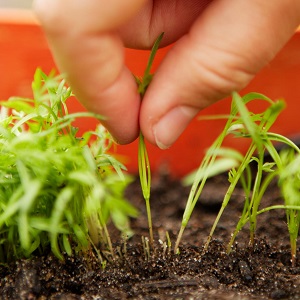 Thin out densely growing seedlings due to frequent sowing of seeds... Otherwise, the roots will intertwine and deform.
Thin out densely growing seedlings due to frequent sowing of seeds... Otherwise, the roots will intertwine and deform.
For the first time, the beds are thinned out after sprouting. The ground is watered and weak shoots are removed, pulling out the shoots vertically. As a result, strong shoots remain on the beds, at a distance of 3.5-4 cm from each other. They are watered with warm (+ 30 ... + 35 ° C) water at the rate of 3-3.5 liters per 1 m².
The soil in the aisles is tamped, loosened and weededby removing weeds that create shade and attract pests.
After 20 days, when the seedlings grow to 8-10 cm, the decimation is repeated. As a result, the distance between shoots should be 6-8 cm.
Top dressing
Losinoostrovskaya is fed with mineral saltscontaining potassium and calcium.
Fertilization scheme:
- 20 days after germination - potassium salt solution;
- after the first thinning - a solution of superphosphate and potassium chloride (1.5 tbsp. l. per 1 bucket of water).
Do not use humus as fertilizer - this will lead to branching of root crops and a decrease in their marketability.
Disease and pest control
Diseases and pestsdangerous for this variety are presented in the table.
| Disease / pest | Signs | Treatment / prevention |
| Fomoz | Gray spots appear on the leaves and petioles. | To prevent the disease, the seeds are heated before sowing at a temperature of + 45 ... + 60 ° C, and during the growing season potash fertilizers are applied to the soil. |
| White rot | A cotton-like bloom appears on root crops, under which mucus accumulates. | To minimize the risk of rot, plantings are watered only with warm water, and before sowing, the soil is fertilized with organic matter. |
| Bacteriosis | The tops turn yellow, brown spots appear on the petioles. | Plants are treated with "HOM" fungicide. |
| Rhizoctonia | Black dots appear on root crops, and gray spots appear under the skin. | Plants are sprayed with copper oxychloride. |
| Carrot fly | The haulm takes on a bronze tint. | For prevention, the soil is dug deeply, and before sowing, it is sprinkled with ash and tobacco dust. |
| Medvedka | Numerous injuries are noticeable on tops and root crops. | In autumn, the soil is deeply dug up and treated with washing powder, kerosene or pepper infusion. |
| Carrot leaf beetle | The tops dries, turns yellow and withers. | The leaves are sprayed with tobacco infusion. |
| Wireworm | The pest is a yellow worm that feeds on roots. | For prevention, plants are fed with ammonium nitrate. |
| Winter scoop | Caterpillars eat greens and the tops of root vegetables. | Plants are treated with "Polytron", "Sherpa", "Decis". |
Growing difficulties
Problems that may arise when cultivating a variety:
- gray spots appeared on the tops - a symptom of phomosis;
- the leaves acquired a bronze tint - the plants attacked carrot flies;
- root crops have slowed down in development - the soil is probably too hot, more watering is required.

Harvesting and storage
Harvested late October - early November, carefully digging in and removing plants from the ground by the tops.
The collected carrots are laid out under a canopy for drying, carefully sorted out, the damaged specimens are thrown away or put aside for early use.
Intact, no signs of damage root vegetables are stored in a dark room at a temperature of 0 ... -1 ° C and air humidity 90-95%.
Subject to the storage conditions, Losinoostrovskaya carrots do not change taste and marketability for 7-8 months.
Tips from experienced gardeners
Experienced farmers recommend:
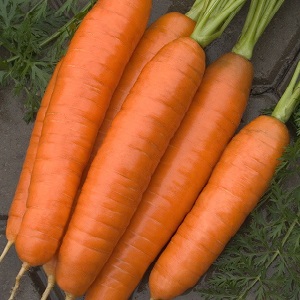 if the bushes are poorly developed, and the foliage turns yellow, use superphosphate and potassium sulfate as fertilizers - this will help to avoid phomosis;
if the bushes are poorly developed, and the foliage turns yellow, use superphosphate and potassium sulfate as fertilizers - this will help to avoid phomosis;- do not plant carrots after herbs and parsnips, planting in the same place is permissible after at least 4 years;
- treat plants with "Immunocytofit" and "Baikal" biological products to increase their protective qualities.
Reviews about the carrot variety Losinoostrovskaya
Gardeners speak positively about the variety.
Maria, Saratov: “I have been planting carrots of this variety on the plot for a long time, I love its sweet taste and juiciness. I like the fact that the use of root crops is universal - we make Korean-style juice and carrots from them. And fresh carrots are very tasty, even the grandchildren eat them with pleasure ".
Olesya, Novokuznetsk: “For me, this variety has some advantages - it requires practically no care, the yield is always at its best, the roots are large, beautiful and tasty. I keep the harvest in the cellar, it lies almost until spring ".
Conclusion
Losinoostrovskaya is a variety of carrots that has no drawbacks and at the same time has a lot of advantages, including frost resistance, immunity to a number of diseases, high yield, good keeping quality and sweet taste of root crops. The variety is suitable for cultivation in private household plots and large farms for commercial purposes.